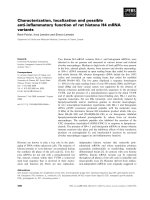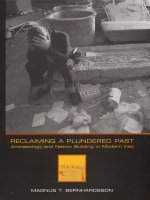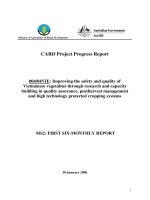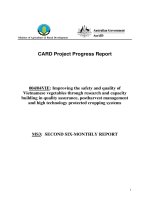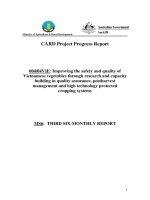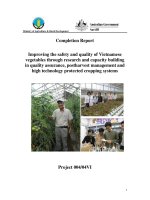Appearance based mobile robot localization and map building in unstructured environments
Bạn đang xem bản rút gọn của tài liệu. Xem và tải ngay bản đầy đủ của tài liệu tại đây (1.57 MB, 143 trang )
APPEARANCE-BASED MOBILE
ROBOT LOCALIZATION AND
MAP-BUILDING IN UNSTRUCTURED
ENVIRONMENTS
MANA SAEDAN
M.Eng (NUS)
A THESIS SUBMITTED
FOR THE DEGREE OF DOCTOR OF PHILOSOPHY
DEPARTMENT OF MECHANICAL ENGINEERING
NATIONAL UNIVERSITY OF SINGAPORE
2007
ACKNOWLEDGMENTS
Four great years in PhD program, I have been indebted for the kindness of many
people. First of all, I will not be here today without the guidance from my supervisor
Dr. Marcelo H. Ang, Jr. His inspiration, encouragement and thrust made me pass
through all hurdles. I would like to thank especially my wife Janjarut, without her I
would not have come this far. Her support and many sleepless nights accompanying
me are most invaluable.
Throughout the program, I met many inspiring people. Their views and expe-
riences definitely affect my life perspective. I would like to thank Professor Alain
Berthoz for the opportunity to work in the Laboratoire de Physiologie de la Per-
ception et de l’Action (LPPA), College de France, Paris. Many thanks to Panagiota
Panagiotagi for her French to English translation and also discussion about our brains!
Julien Diard for his assistance and advice so I had no difficulty while in France.
My colleagues and friends are never less important. Koh Niak Wu, Tirthankar
Bandyopadhyay, Lee Gim Hee, and Li Yuanping: I would like to thank them for
sharing and discussing the work. Lim Chee Wang for his full support during the
period I worked at Singapore Institute of Manufacturing Technology (SIMTech). I
sincerely appreciate supports from technicians and laboratory officers of the control
and mechatronics lab.
ii
Lastly, I would like to dedicate this work to my parents, Mr. Thongdee and Ms.
Ampai, they are truly my angels.
iii
SUMMARY
Machine vision has gained in popularity for use as a main sensor modality in
navigation research because of its relatively low cost compared to other sensors. Fur-
thermore, vision provides enormous information about an environment. We develop
a vision-based navigation system that is inspired by the capability of humans to use
eyes (vision) to navigate in daily lives.
The contributions of the Ph.D. work are as follows:
• Direct image processing of a (circular) image from a catadioptric (omnidirec-
tional) camera system.
• Localization using vision and robot odometry with a hybrid representation of
the world using topological/metric map.
• Integration of feature map building and localization to incrementally build a
map and solve the “loop closing” problem, make the system applicable in un-
known, dynamically changing environments with good performance in large
indoor areas.
• Integration of appearance-based simultaneous localization and map-building
with navigation to a goal.
iv
TABLE OF CONTENTS
Page
Acknowledgments ii
Summary iv
ListofFigures ix
ListofTables xvi
Nomenclature xvii
Chapters::
1. Introduction 1
1.1 State-of-the-ArtLocalizationandSLAMalgorithm 3
1.2 Vision-BasedNavigation 5
1.3 SummaryofContributions 9
2. Probabilistic Algorithms in Vision-based Robot Navigation . . 12
v
2.1 KalmanFilter 14
2.2 MixtureofGaussian(MOG) 16
2.3 ParticleFilter 16
2.4 Summary 19
3. ImageProcessingforVision-BasedNavigation 20
3.1 FeatureExtraction 20
3.1.1 SalientLocationIdentification 22
3.1.2 NeighborhoodPixelExtraction 24
3.1.3 FeatureDescription 26
3.2 ImageMatching 28
3.2.1 GlobalMatching 30
3.2.2 LocalMatching 35
3.3 ExperimentalResults 37
3.4 Summary 39
4. Appearance-basedLocalizationinanIndoorEnvironment 40
4.1 SystemModeling 41
4.1.1 StateModelofaRobot 41
4.1.2 Measurement(Observation)Model 42
4.2 DisbeliefAlgorithm 43
4.3 Self-LocalizationExperiment 45
4.4 Summary 49
vi
5. Appearance-based Simultaneous Localization and Map-Building (SLAM) 53
5.1 Appearance-BasedSLAM 54
5.1.1 MapRepresentationandParticleSampling 56
5.1.2 ParticleWeightUpdate 59
5.1.3 TrackingWindowtoEstimateRobotPosition 61
5.2 Appearance-BasedMap-building 63
5.2.1 OracleModel 64
5.3 MapManagement 67
5.3.1 UpdateAbsolutePositionsofMapNodes 69
5.4 ExperimentalSetupandResults 71
5.5 IntegrationofSLAMandNavigationtoaGoalTasks 85
5.6 Summary 92
6. ConclusionsandFuturework 93
6.1 FutureWork 93
6.1.1 OptimumAreaCoverageofMapNodes 94
6.1.2 AppearanceParametersAdjustingandLearning 94
6.1.3 FusionwithRangeSensors 95
6.1.4 CombinationwithMetricalMap 95
Appendices:
A. AlgorithmsforAppearance-BasedRobotNavigation 96
vii
A.1 AlgorithmsforImageMatching(Chapter3) 99
A.2 AlgorithmsforLocalization(Chapter4) 105
A.3 AlgorithmsforSLAM(Chapter5) 112
Bibliography 120
viii
LIST OF FIGURES
Figure Page
1.1 Mainconceptofappearance-basednavigation 8
2.1 Overviewofparticlefilteralgorithm 18
3.1 The coordinate system of an image in our application. The origin of
the image at the bottom-left corner. In this example, the image is 4×4
pixels. 21
3.2 Anoverviewoffeatureextractiononanomnidirectionalimage 22
3.3 Example of wavelet decomposition on the original image 224 × 224
pixels. Wavelet decomposition are performed four times recursively.
Each matrix in the last level of decomposition has size 14 × 14 pixels 24
ix
3.4 Tracking salient location from the second level of signal matrix to origi-
nal image. The first location-candidate starts from the top-right of the
second signal matrix which has signal value a. This signal point can be
viewed as it has 4 children in the first signal matrix. Hence, the child
(with signal value b) that has maximum signal value is selected. The
exact location-candidate is identified from the pixel of 4 child-pixels
in the original image that has highest gradient magnitude. The signal
strength of this particular candidate is equal to a + b 25
3.5 The process of salient point identification and neighborhood pixel ex-
traction. In (a) - (c), the identification is performed on the original
image. Whereas (d)-(f), the identification is performed on a the rotated
(by90degreescounterclockwise)image 27
3.6 Theoverviewproceduretoformthedescriptorofasub-image 29
3.7 Constructionofthefirstk-dtree. 32
3.8 Thefinalk-dtreeof5featuresinFigure3.7 32
3.9 The first iteration of the Best Bin First search (BBF) algorithm. . . . 34
3.10 (Top) Query image submitted to the global matching. (Bottom) The
candidate results from global matching, The confidence score S
c
=5.5. 36
x
3.11 Global matching accuracy vs. maximum search candidates. The total
database feature points are 24320 points. 38
3.12 Matching time vs. maximum search candidates (Pentium-M 1.6 GHz
notebookcomputer). 38
4.1 The average confidence score of the query images inside and outside the
sensitive area of the map nodes (20 cm radius from the corresponding
mapnode). 44
4.2 (Top) the robot for the experiments was equipped with the omnidi-
rectional camera. (Bottom) the floor plan of the laboratory, and the
travelingrouteoftherobotduringmaplearningphase 46
4.3 Snapshots of particle distribution during the first kidnapping trials.
The robot was kidnapped immediately after time step 80
th
.Thestar
indicates the true position of a robot, and the square with cross mark
indicatestheestimatedlocation 50
4.4 Snapshotofparticle(Continued1) 51
4.5 Snapshotofparticle(Continued2) 52
xi
5.1 Globalmapstructurestoredinmemory. 57
5.2 Events in time sequences prior creating a new map fragment. Mapping
area is defined by a white area. The shaded node is the reference node
ofarobot 58
5.3 Localmapconstructionduringparticlesamplingprocess 60
5.4 The circular tracking window estimates the current robot pose. Size of
the window is adjusted until a number of particles inside the window
ismorethan50%oftotalnumberofparticles. 62
5.5 The distribution of Oracle(ξ
ξ
ξ
t
) when a confidence score from global
imagematchingreachesdisbeliefthreshold 65
5.6 The distribution of Oracle(ξ
ξ
ξ
t
) when new node is added to a map. . . 65
5.7 OverviewofSLAMalgorithm 66
5.8 When a robot traverses farther than a relocation area of a particle, the
relocated particles do not represent the true state of a robot. In this
scenario, particles may never converge at the true robot location. . . 68
xii
5.9 A robot revisits node i afteritcamefromnodeN. Hence, the map-
loop is detected. The left figure shows the robot location before the
map-loop is detected, and the right figure shows the robot location
after the loop is detected. As shown in the right figure, the locations
ofnodeibeforeandafterloopdetectionaredifferent 70
5.10 Path reconstruction from the map when node 1 is revisited. The for-
ward path extracts locations of nodes from the current locations of
nodes in the map. p
f
and p
b
are the position of node i in the for-
ward and backward direction, respectively. The backward path is con-
structed from the node in reverse order. The constraint on both path
construction is p
f1
= p
b1
72
5.11 The floor plan and travel route of the sixth level of our building. . . . 74
5.12ThefloorplanandtravelrouteoftheSSC 75
5.13 The differential-wheel robot used in the experiments equipped with the
SICKlaserandtheomnidirectionalcamerasystem. 76
5.14 The plot of odometry and laser scan data from level sixth of EA-building. 77
5.15TheplotofodometryandlaserscandatafromtheSSC. 78
xiii
5.16 The map result before and after loop closing at level sixth of EA-block. 81
5.17 The map result before and after loop closing at the Singapore Science
Center 82
5.18 Localization error after closing loop. At time step 79 - 109, the new
map fragment was created before it was merged with the existing map
fragment. 83
5.19 Mapping result with the inter-node distance R
Map
= 100 cm.The
cross-marks are the location of each map node obtaining from robot
odometry. 84
5.20 Mapping result with the inter-node distance R
Map
= 150 cm.The
cross-marks are the location of each map node obtaining from robot
odometry. 84
5.21 Mapping result with the inter-node distance R
Map
= 200 cm.The
cross-marks are the location of each map node obtaining from robot
odometry. 85
5.22 Overview of the appearance-based autonomous robot navigation system. 86
xiv
5.23 Determine the desired path after obtain the immediate destination
nodeformDijkstraalgorithm. 87
5.24 Map of the lab during the experiment of autonomous navigation to a
goal. The starting location is at node ID=1 and the ending location is
atnodeID=24. 88
5.25Failurelocationofarobotfrombothtests 89
5.26 Comparison of localization errors between navigation with odometry
alone and with SLAM. The robot started from Node ID=1 and traveled
toNodeID=21. 90
5.27 Example of trajectory of a robot during navigation based on odometry
alone. 91
5.28 Example of successful trajectory of a robot during navigation with
SLAM 91
xv
LIST OF TABLES
Table Page
4.1 Timestepsbeforeparticlesconverged. 46
4.2 Performanceofourlocalizationalgorithm 48
5.1 Parametersforimageprocessing 73
xvi
NOMENCLATURE
I An image array size W × H pixels, where W and H are width and height of the
image.
D The feature database of N images.
Q The features of a query image Iq.
G(Q, D) Global image matching of the query features (image) to the database.
S
c
Confident score of the global image matching between a query image and a
database
D
c
Image candidates given by the global matching that resemble the query image
D
c
⊂ D
L(Q, D
n
) The local matching between a query features and a given reference image
features D
n
⊂ D.
S
n
The similarity score of local matching between between a query image and given
reference image n in database.
φ
n
The image rotation angle between a query image and a reference image n.
xvii
ξ
ξ
ξ The state of a robot, in this thesis ξ
ξ
ξ =
nx
n
y
n
θ
n
T
,wheren is the identi-
fication number (ID) of the reference node and (x
n
,y
n
,θ
n
) is the location of a
robot with respect to the reference node.
Bel(ξ
ξ
ξ
t
) The conditional probability density of a current robot state on series of ob-
servations and control inputs.
p(ξ
ξ
ξ
t
|ξ
ξ
ξ
t−1
, u
t−1
) The motion model: a conditional probability of current robot state
on previous control input and previous robot state.
p(y
t
|ξ
ξ
ξ
t
) The observation model: a conditional probability of a current sensor reading
on the current robot state.
T
d
The disbelief threshold of the confident score. At any instance the confident score
is higher than the disbelief threshold, the disbelief algorithm is activated to
re-initialize portion of particles to new location(s) according to the results from
global image matching.
d
n
The distance of a robot from its reference node d
n
=
x
2
n
+ y
2
n
.
R
Map
The preferred inter-node distance in SLAM system. The SLAM may add a
new node only when a distance d
n
is larger than R
Map
.
T
Map
The mapping threshold on the confident threshold. When S
c
<T
Map
and
d
n
>R
Map
, new map node is added to the existing map.
Oracle(ξ
ξ
ξ
t
) The oracle model assisting in the relocation of particles.
xviii
CHAPTER 1
INTRODUCTION
The ability of human beings to use vision to navigate in daily lives has inspired us
to investigate vision to be used as a primary external sensor for robot localization and
simultaneous localization and map-building (SLAM). We can remember and relate
places without explicitly knowing their exact locations. This motivates us to develop a
vision-based navigation algorithm, where a robot recognizes landmarks and uses them
to navigate to the goal. Such approaches have been referred as appearance-based
navigation [1]. Our system combines visual information with metrical information
resulting in a hybrid map, which consists of a topology of landmarks (visual images)
and their relative location and orientation (relative odometry).
Recently, appearance-based localization has gained more popularity among mobile
robotics researchers, perhaps due to the approach is still under explored and recent
technological advances in computer and vision hardware. The main difference between
appearance-based and other approaches is the method to represent the environment.
The appearance-based approach relies on remembering features of the environment
rather than explicitly modeling it. Many work in this field such as [2, 3] were inspired
by biological counterparts.
1
Early implementations of appearance-based localization [2] and [4] involved quite
complicated image processing and matching techniques. The ultimate aims of those
methods are to obtain the location of a robot by finding an image stored in the map
that matches best with a query image. Their work were either tested in a static
environment or a specially structured one. More recently, many implementations
attempted to deal with realistic environments. These algorithms incorporated prob-
abilistic techniques with relatively simpler image processing algorithms. We follow
the latter approach to implement our robot navigation. Recent work by Gross et
al. [5], Menegatti et al. [6] and Andreasson et al. [7] demonstrated the success of
incorporating vision in appearance-based localization. Nevertheless, there are still
many challenges before appearance-based localization becomes pervasive.
An image contains rich information of the environment compared with other sensor
data. However, high computational requirement to interpret the image prohibits it to
be used directly in the robot localization algorithm. As a result, many appearance-
based localization researchers focus their efforts to develop methods of extracting
robust features from an image. For example, the Fourier coefficients are used in [6],
and the scale invariant feature transform (SIFT) are adopted in [7]. Such features
extracted are normally not spread over the entire environment and/or associate some
geometric meaning to the object in the environment. In our work [8, 9], however we
develop techniques to extract features directly from original (circular) omnidirectional
images without projecting them to any other surfaces. This results in a marginal
increase in computational speed, and locations of the features in the image are always
spread over the entire image. Hence, our algorithm is naturally robust to occlusions
which may hide geometric features.
2
The bottle neck of the appearance-based approach is the time spent in the im-
age matching process in spite of the availability of low dimensional image features.
This limits many approaches, and makes them impractical in very large scale envi-
ronments. Consequently, we try to ease the limitation by developing the localization
technique to be able to work in a map that has relatively few reference images of an
environment. Although our technique sacrifices accuracy of the localization system
for the applicability to a large scale map, we can still maintain overall robustness of
the system.
In this thesis, we present details of the theoretical developments and the practical
implementations of our navigation. The methodology presented in this thesis achieves
the following goals:
• To provide efficient method in processing an image that is directly obtained
from the catadioptric vision system.
• To explore fast image matching mechanism that enables the real-time imple-
mentation of robot navigation in large scale indoor environment.
• To develop an algorithm that performs localization and/or simultaneous local-
ization and map-building in realistic indoor environment (SLAM).
• To initiate a framework for integrating (SLAM) with other navigation tasks.
1.1 State-of-the-Art Localization and SLAM algorithm
The SLAM algorithm deals with uncertainties of a model of an environment (map)
and a drobot location from the same external sensor source(s). Although initial re-
ports on the state-of-the-art algorithm utilized only the geometric information of
3
environment, they laid a crucial insight into the problem. The SLAM problem be-
came very active since mid 1980s. Among various algorithms, the probabilistic-based
approaches are reported to have superior performance over other methods. In partic-
ular, the problem is solved using a family of recursive Bayesian filters.
Smith and Cheeseman [10] is one pioneering work that is able to operate online to
acquire the map information from a sensor. Another work of Dissanayake et al.[11]
presented the extended Kalman filter to solve a robot location in two-dimensional
space (x, y, θ) and a coordinate point landmark. The weakness of the algorithm is that
the complexity of the algorithm is quadratic to the number of landmark in the map
as the filter maintains a full correlation between robot and all landmarks. To reduce
complexity, Thrun et al. [12] proposed the sparse extended information filter (SEIF)
that only preserves the relationship among landmarks locally. The difference between
the Kalman filter and the information filter is that the Kalman filter maintains a
covariance matrix whereas the information filter maintains the inverse of covariance
matrix, which is also known as information matrix.
Although the performances of those algorithms discussed earlier are well accepted
in terms of computational speed and accuracy, they share the same disadvantages.
That is, they rely on a “good” correspondence between sensor data and landmark(s)
to ensure the filters convergence toward a true solution. Furthermore, due to the
complexity of matching, the sensor data is pre-processed to extract some features.
Therefore, much useful information of environment is discarded.
Thrun et al. [13] offered another solution to deal with the correspondence issue
and also enable the operation of SLAM to much larger environment. The algorithm is
known as “FastSLAM”, which is based on a Rao-Blackwellised particle filter (RBPF)
4
fusing with tree structure algorithm. The FastSLAM is able to tolerate false corre-
spondences since any particles with wrong data association tend to be depleted in
next few time steps.
1.2 Vision-Based Navigation
Vision has several attractive properties such as it is a passive device that requires
less power consumption. Moreover, the information from vision is very rich. It is able
to provide color, texture and/or geometry of environment. The vision hardware in
navigation can be classified into two main groups: perspective and omnidirectional.
The perspective camera is a typical camera setup; the setup may utilize more than
one camera to obtain depth information from image disparities. Whereas, the om-
nidirectional camera provides the full horizontal view of surrounding space in single
snapshot. Therefore, a robot can view a surrounding environment regardless of its
heading direction. The popular choice of omnidirectional camera system is known as
a catadioptric camera system. The system normally comprises of a curvature mir-
ror, e.g. parabolic or hyperbolic mirror, and a normal perspective camera. The raw
image from the catadioptric camera system is highly distorted. Therefore, it is often
mapped into some other surfaces to correct the distortion. The resulting image can
be either in panoramic or normal perspective view.
Utilizing information directly from raw image can lead to slow computing. Early
implementation [14] of vision navigation usually involved compressing image to much
lower resolution. However, some useful cue may be lost during the compression pro-
cess. As a result, many researchers try to develop other methods to reduce the
dimension of an image with minimal loss of information. Gross et al. [5] divided a
5
panoramic image (obtained from a catadioptric vision system) into smaller segments.
Subsequently, the averaged red, green and blue color components of each segment are
computed, and then stacked up to form a feature vector representing the whole image.
Menegatti et al. [15] formed a “Fourier signature” of a panoramic image. The size of
a final feature is tremendously reduced from an original image. Winters and Santos-
Victor [16] utilized the information sampling technique to determine most distinctive
area of a particular image from other images in previous time steps. More recently,
Lowe [17] proposed the solution to extract and assign some features of an image. The
algorithm is known as the scale invariant feature transform (SIFT). The algorithm
is widely adopted by many researchers such as [18, 19, 7, 20]. Kasparzak et al. [21]
compared several image features for their localization system. The perspective image
is divided into small sub-images, and then features such as FFT, color moment and
average color components were applied to those small sub-images.
Results of image processing can be either used directly in the estimation or in-
ferred further to obtain a metrical information of an environment. The extended
Kalman filter (EKF) was used in [22, 23, 24, 25, 26, 20]. Their methods require
the availability of explicit sensor model of an environment. Consequently, the metric
information (e.g. position of a landmark) is normally extracted from an image. Be-
cause the Kalman filter maintains only a single Gaussian probability distribution, it
cannot handle multiple hypotheses situation, e.g. global localization. Therefore, all
implementations above does not discuss methods to solve kidnapping and map-loop
closing problem. These are the problems that cause a Kalman filter to often yield
poor performance. The first problem, robot kidnapping, is the problem where a robot
is relocated suddenly without resetting the location of a robot. The map-loop closing
6
